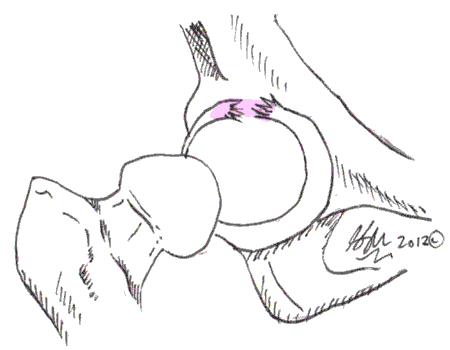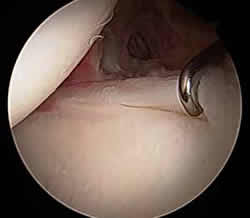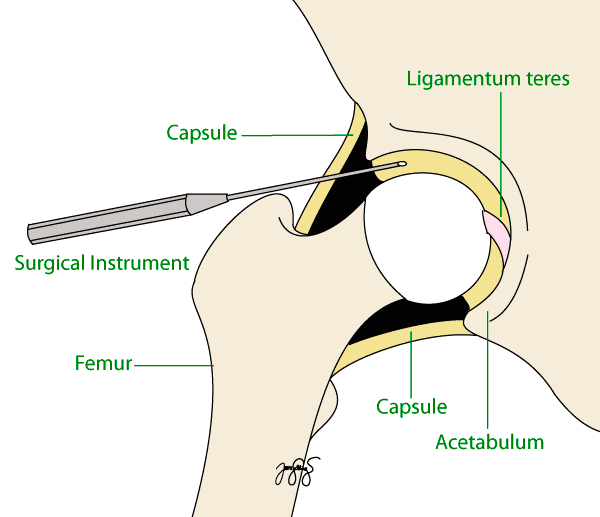A hip labral tear involves the ring of soft tissue that follows the outside rim of the socket of your hip joint. This ridge of cartilage, called a labrum, works a little like a suction cup to help hold your hip joint together.
Athletes who participate in such sports as ice hockey, soccer, football, golfing and ballet are at higher risk of developing a hip labral tear. Structural abnormalities of the hip can also lead to a hip labral tear.
Signs and symptoms include hip pain or a “catching” sensation in your hip joint. Initial treatment may include pain relievers and physiotherapy. Using arthroscopic techniques, surgeons can remove loose fragments from within the joint and trim or repair the hip labral tear.

Symptoms
Many hip labral tears cause no signs or symptoms. Initially, the pain may only be felt whilst playing sport. As symptoms progress, you may feel:
- A locking, clicking or catching sensation in your hip joint
- Pain in your hip, groin or knee
- Stiffness or limited range of motion in your hip joint
With time, you may feel pain with any movement that brings your knees towards your chest, such as:
- sitting in low chairs
- getting up from chairs
- driving
- putting on your socks and shoes
- picking things off the ground
- climbing stairs
Sometimes, you may hear an audible pop or feel a tearing sensation at the time of injuring your labrum.
Causes
The cause of a hip labral tear may be:
- Trauma: Injury to or dislocation of the hip joint — which can occur during car accidents or from playing contact sports can cause a hip labral tear.
- Structural abnormalities (FAI): One of the most common causes of a labral tear is having a condition called femoroacetabular impingement, also called FAI. In FAI, the bones that make up your hip joint are not perfectly shaped. Your hip joint is a ball and socket joint. In FAI, either the femoral head (the ball) has a bump or the acetabulum (the socket) has extra bone on its edge. These extra bone lumps cause abnormal pressure on the labrum, eventually causing it to tear.
- Repetitive motions: Sports-related and other physical activities — including the twisting or pivoting motions common in golf or softball — can lead to joint wear and tear that ultimately results in a hip labral tear. Sudden changes in direction such as in AFL football, soccer, hockey and netball can also lead to this injury.
- Osteoarthritis: Degenerative changes can increase the friction inside your hip joint, which can lead to a hip labral tear.
- Age: As you get older, the labrum can easily be torn with small trivial movements.
Risk Factors
The following factors may increase your risk of a hip labral tear:
- Overuse. People who participate in sports or other activities that require repeated twisting or pivoting motions are more likely to experience a hip labral tear.
- Pre-existing hip problems. Conditions or diseases that increase the amount of friction within the hip joint may increase the risk of a hip labral tear. The most common of these is femoroacetabular impingement (see section).
Investigations
A hip labral tear rarely occurs in isolation. In most cases, other structures within the hip joint have also sustained injuries. Diagnostic tests can help determine exactly what’s going on inside your joint.
Imaging scans

- X-rays. X-rays are excellent at visualizing bone. They can check for fractures and for structural abnormalities.
- Magnetic resonance imaging (MRI). Using a strong magnetic field, MRIs provide detailed images of soft tissues. A contrast material may be injected into the hip joint space to better define a labral tear that may be present.
Anesthesia injection
Hip pain can be caused by problems within the joint or outside the joint. Your doctor may suggest injecting local anaesthesia into the joint space. If this relieves your pain, it’s likely that your problem is inside your hip joint.
Complications
A hip labral tear may predispose you to develop osteoarthritis in that joint in the future.
Treatment
Treatment choices will depend on the severity of your symptoms. Some people recover with conservative treatments in a few weeks, while others may require arthroscopic surgery to repair or remove the torn portion of the labrum.
Medications
Nonsteroidal anti-inflammatory drugs (NSAIDs), such as ibuprofen and naproxen (Aleve, others), can relieve pain and reduce inflammation.
Allied Health
A physiotherapist can teach you exercises to maximize hip range of motion and hip strength and stability. A physiotherapist can also analyze the movements you perform that put stress on your hip joint and help you avoid these forces.
Surgery
If you have a hip labral tear and experience hip pain for more than four weeks, your doctor may recommend arthroscopic surgery — in which a fiber-optic camera and surgical tools are inserted via small incisions in your skin.
Depending on the cause and extent of the tear, the surgeon may cut out and remove the torn piece of labrum or repair the torn tissue by sewing it back together.

Seeking Advice
Your Family Doctor (GP)
Your Family Doctor will be able to diagnose and help treat your problem. He or she will be able to
- tell you about your problem
- advise you of the best treatment methods
- prescribe you medications
- and if necessary, refer you to Specialists (Consultants) for further treatment
While you may initially consult your family doctor (GP), he or she may refer you to a doctor who specializes in hip disorders or sports medicine.
Bring along information about yourself
It can be a great help for your doctor if you bring along the following information about yourself
- A list of your medications, including the name and dosage.
- Information about your medical problems and past treatment
- Previous investigation results, such as xrays and blood tests.
Prepare a list of questions for your doctor
You may want to write a list that includes:
- Detailed descriptions of your symptoms
- Information about medical problems you’ve had
- Information about the medical problems of your parents or siblings
- All the medications and dietary supplements you take
- Questions you want to ask the doctor
What to expect from your doctor
Your doctor may ask:
- Where exactly does it hurt?
- When did the pain start?
- Did anything precipitate it?
- Does any action make the pain better or worse?
During the physical exam, your doctor will move your leg, and especially your hip joint, around in various positions to check for pain and evaluate your hip’s range of motion. He or she may also want to watch you walk. Your doctor may also check the musculoskeletal and neurological health of your hip joint and leg by testing your:
- Reflexes
- Muscle strength
- Muscle tone
- Sensation
- Coordination
- Balance
Prevention
It is difficult to prevent a labral tear as often it is due to an injury that may not be foreseen. However if there is an underlying structural abnormality of the hip, such as femoroacetabular impingement, then getting this treated may prevent a labral tear occurring.
